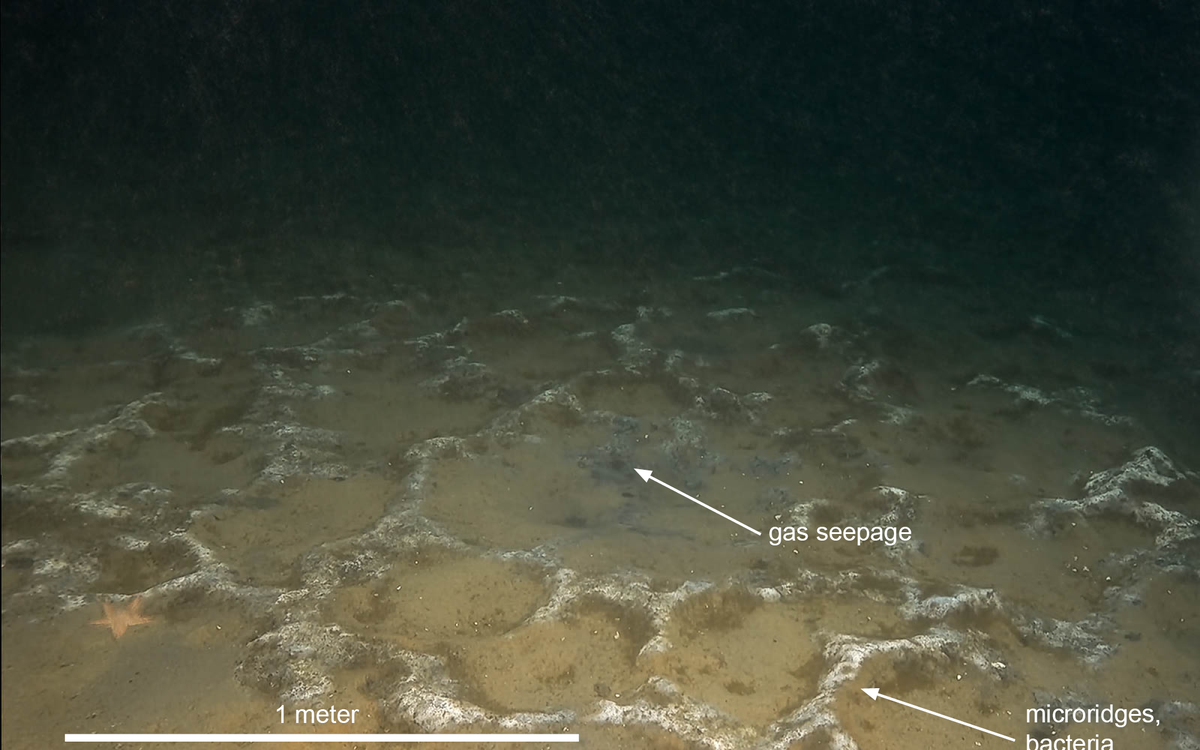
Polygonal network of bacterial ridges a few centimeters high. The dark area in the center of the figure shows one of the gas venting points seen in the video.

Polygonal network of bacterial ridges a few centimeters high. The dark area in the center of the figure shows one of the gas venting points seen in the video.
Published: 27.06.2025 Updated: 01.07.2025
The research vessel G.O. Sars arrived at the site Friday morning, after more than 20 hours of sailing from Bergen. Upon arrival at the site, the video rig was lowered to the seabed, where the anticipation was immense. The rig landed on the bottom, stirring up the usual cloud of sediment, and slowly, we could observe the seabed. Not particularly exciting at first – a sandy bottom with some small depressions where dead organic material had accumulated. The video rig was then lifted a meter or two above the seabed, and the ship began towing it along a pre-determined 200-meter-long transect.

Suddenly, white patches appeared on the seabed – an unmistakable occurrence of bacterial mats that feed on gas seeping up from the subsurface. These bacterial mats are fairly common occurrences close to gas seeps but usually appear as irregular patches. Here, the pattern of the bacterial mats was completely different! The bacteria formed micro-ridges arranged in a pattern resembling a polygonal honeycomb pattern or the cracking of a mudflat as it dries. We are still uncertain of why the bacteria accumulates in ridges in this way, but it is tempting to speculate that these polygonal networks may be caused by gas seeping up along cracks or feeding zones. We also saw several darker fields where gas escaped from the seabed, possibly related to bacteria as well.
In gas seepage areas, larger organisms like tube worms are often found, but generally deeper than this site is. Another common feature associated with gas seepage is the formation of so-called authigenic carbonate crusts - cement-like slabs that can be several meters wide and tens of centimeters thick, formed as a result of microbial processes that bind together the sediment through which the gas flows. We haven’t observed any tube worms or carbonate crusts in the video, but we collected a sample of the sediment that may be interesting for further analysis.
In several locations, we also saw gas bubbles slowly rising from the seafloor - bubbling for a few seconds, followed by a pause of a minute or two. Note that there is a lot of “marine snow” in the video. In the image above, most of the snow has been removed by stacking 20 video frames and using AI.

The area was first investigated by the University of Bergen in 2023. Echosounder surveys at the time observed numerous gas bubbles in the water column. The site had been selected for investigation based on seismic data and other geological information. The seismic data clearly indicates a shallow gas pocket in the subsurface, with gas migrating up to the seabed - some of which is now confirmed visually with the video rig. In 2026, the area will be further investigated with an ROV as part of the InFluSe project (Integrated study of Fluid Migration and Seepage in the Southern Norwegian North Sea – Impact on Hydrocarbons, Environment, and CO₂ storage).
Interested in learning more about gas seeps in Norwegian waters? Here’s an article that provides an overview: Thorsnes, T., Chand, S., Bellec, V., Nixon, F.C., Brunstad, H., Lepland, A., & Aarrestad, S.M. 2023: Gas seeps in Norwegian waters – distribution and mechanisms. Norwegian Journal of Geology 103, 202309.